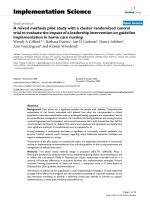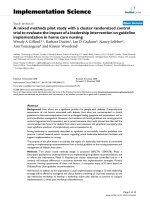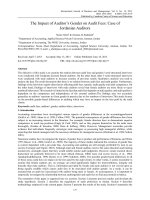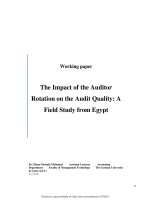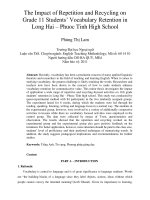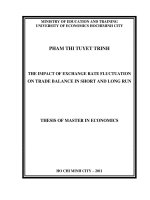IMPACT OF STATE BUDGET DEFICIT ON GOVERNMENT DEBT IN VIETNAM
Bạn đang xem bản rút gọn của tài liệu. Xem và tải ngay bản đầy đủ của tài liệu tại đây (1.32 MB, 115 trang )
MINISTRY OF EDUCATION AND TRAINING
FOREIGN TRADE UNIVERSITY
--------o0o--------
DISSERTATION
IMPACT OF STATE BUDGET DEFICIT ON
GOVERNMENT DEBT IN VIETNAM
Major: International Trade and Policy in Vietnam
Full Name: Nguyen Thi Hong Quyen
SUPERVISOR: Assoc.prof. Dr. Hoang Xuan Binh
Ha Noi - 2016
ACKNOWLEDGEMENT
This postgraduate research project could not be accomplished without the strong
supports from my supervisor from Foreign Trade University, colleagues at the
Department of Debt Management and External Finance, who I have been working
with over the last 5 years. What I have found during my time working here was the
primary inspiration of selecting this very typical topic, along with great
encouragements from family and friends. Throughout the process of completing this
project, I have encountered many difficulties from data collection, analysis and
interpretation. I would like to take this opportunity to acknowledge such
appreciations to my colleagues, who have offered their devotions to assist myself
from establishing this research work.
First and foremost, I would like to express my greatest gratitude to my
supervisor, Associate Professor, Doctor Hoang Xuan Binh, who has been overseen
the progress of my entire research project over the last 7 months. Sincerely, if this
project was not under his guidance, patience, motivation and academic suggestions
on some of my weaknesses, I would not have managed efficiently to finish this study.
I greatly cherish the opportunity that my colleagues gave to me, to learn on perfecting
my work professionally. It was one of my greatest experiences with supervisors and
colleagues throughout five years working in the Debt Management and External
Finance, Ministry of Finance .
Without any doubt, I would like to thank my family, classmates and colleagues.
Throughout a long stressful time doing the year-round project, I could not express
any greater gratefulness to them, standing by my side and support intellectually.
2
TABLE OF CONTENTS
ACKNOWLEDGEMENT ........................................................................................1
LIST OF FIGURES, GRAPHS AND TABLES .....................................................5
LIST OF ABBREVIATIONS...................................................................................7
CHAPTER I. INTRODUCTION .............................................................................8
1.1.
Urgency of subject ....................................................................................... 8
1.2.
Researching overall on budget deficit and government debt. ................. 9
1.3.
The objectives of research ......................................................................... 11
1.4.
Scale and subjects of the research ............................................................ 11
1.3.
Method of research .................................................................................... 12
1.4.
Scientific and practical meaning of the research .................................... 13
1.5.
Structure of the research .......................................................................... 13
CHAPTER II: LITERATURE REVIEW.............................................................14
2.1.
Theories relevant to the research ............................................................. 14
2.1.1.
State budget .........................................................................................14
2.1.2.
Public debt and government debt .....................................................17
2.1.3. Some theoretical research framework ..................................................... 19
2.2.1.
Debt burden indicators .......................................................................33
2.2.2.
Debt sustainability ..............................................................................35
2.2.3.
Baseline Scenario ................................................................................38
2.2.4.
Standardized stress tests ....................................................................41
2.2.5.
Shocks Analysis in DSF and in DSA .................................................60
CHAPTER III: METHODOLOGY AND DATA SOURCES ............................63
3.1.
Research procedure ................................................................................... 63
3.2.
Data description ......................................................................................... 66
3.3.
Research assumption ................................................................................. 68
3.3.1. Building a model for Vietnam case .......................................................... 68
3.3.2.
Domestic Financing Instruments: ......................................................70
3.3.3.
External Financing Instruments: .......................................................71
CHAPTER IV. FINDINGS AND DISCUSSION .................................................77
4.1.
Alternate scenarios of Primary Deficit .................................................... 77
3
4.1.1.
Average Primary Balance ....................................................................77
4.1.2.
Revenue-expenditure structure ...........................................................79
4.1.3.
Annual budget deficit reduction schedule ..........................................83
4.2.
Financing Strategy ..................................................................................... 87
4.2.1.
Financing Sources: Domestic versus External ..................................87
4.2.2.
Tenor of new Borrowing ......................................................................89
4.3.
Exchange rate ............................................................................................. 95
4.4.
Interest of domestic and external borrowings ........................................ 97
4.4.1.
Interest of new domestic borrowings...................................................98
4.4.2.
Interest of new external borrowings ...................................................99
4.5.
Notes on Nominal GDP ........................................................................... 101
4.6.
Summary of findings ............................................................................... 101
CHAPTER 5. CONCLUSION AND POLICY RECOMENDATION .............104
5.1.
Conclusion review and Policy recommendation ................................... 104
5.1.1.
Effective fiscal deficit control ..........................................................104
5.1.2.
In short-term Vietnam properly forcuses more on controlling
effectively expenditures, in middle and long terms, gradually changing
expenditure structures under state budget to consolidate fiscal policy. ...105
5.1.3.
Developing domestic capital market should be first and foremost
priority. ............................................................................................................105
5.1.4.
A benchmark yield curve of government bond can serve as a
strategic management of financing cost .......................................................107
5.2.
Suggesstions for further research .......................................................... 108
LIST OF REFERENCES .....................................................................................110
4
LIST OF FIGURES, GRAPHS AND TABLES
Figure 1: Negative shock to real GDP growth (PDSA) - impact on the level of
gross financing needs
Figure 10: Negative shock to non-debt creating flows - impact on the level of
gross financing needs
Figure 11: Negative combination shock - impact on the level of gross financing
needs
Figure 2: Exchange rate depreciation (PDSA) - impact on the level of gross
financing needs
Figure 3: Shocks to the Primary Balance (PDSA) - impact on the level of gross
financing needs
Figure 4: Negative shock to primary balance and read GDP growth - impact on
the level of gross financing needs
Figure 5: Contingent liability shock - impact on the level of gross financing
needs
Figure 6: Key variables set to historical averages - impact on the level of gross
financing needs
Figure 7: Shocks to financing terms - impact on the level of gross financing
needs
Figure 8: Two-year shock to export growth - impact on the level of gross
financing needs
Figure 9: Negative shock to the GDP deflator in US dollar terms - impact on the
level of gross financing needs
Graph 1: Interest Payment to revenue and Primary Revenue to GDP
Graph 2: Evolution of Annual Gross financing needs in different scenarios
Graph 3: Evolution of Interest Service in different scenarios
Graph 4: Evolution of Debt to GDP in different scenarios
Graph 5: Evolution of External Debt to Total Debt in different scenarios
Graph 6: Evolution of Annual Rollover Amount in different scenarios of new
borrowings tenor
Graph 7: Evolution of Annual Gross financing needs in different scenarios of
Vietnam dong depreciation
5
Graph 8: Evolution of Annual Gross financing needs in different scenarios of
new borrowing cost
Table 1: General Government Net Debt of some countries, 2007- 2021
Table 2: Risk classification and CPIA Score
Table 3: Stress Tests in PDSA and EDSA
Table 4: Summary of Macro-Fiscal Stress Tests
Table 5: Definition of External Instruments
Table 6: Summary of baseline scenario assumptions
Table 7: Debt indicators in Baseline Scenario
Table 8: Baseline scenario – break down of GFN
Table 9: Debt Indicators in scenarios of Average Primary Balance
Table 10: Evolutions of Debt indicators to stabilize debt to GDP ratio
Table 11: Debt Indicators in scenarios of Revenue – Expenditure structure
Table 12: Scenario 1 –Annual Primary Deficit remains at 3.4% GDP
Table 13: Scenario 2 – Increasing Annual Primary Deficit / GDP
Table 14: Debt indicators in scenarios of average new domestic tenor
Table 14: Debt indicators in scenarios of domestic financing ratio
Table 16: Debt indicators in scenarios of average new external tenor
Table 17: Debt indicators in scenarios of annual VND depreciation
Table 18: Debt indicators in scenarios of new domestic borrowing cost
Table 19: Debt indicators in scenarios of new external borrowing cost
6
LIST OF ABBREVIATIONS
ATM
DSA
DSF
EDSA
EMs
EUR
FDI
FTA
GBP
GDP
GFN
IDA
IMF
LIC DSA
MAC DSA
MOF
PDSA
PV
TPP
USD
VND
WAL
WB
NPV
LCU
NICA
X
CA
M
NT
NI
INT
IR
CPIA
PD
PPG
Average time to maturity
Debt sustainability analysis
Debt sustainability framework
External Debt sustainability analysis
Emerging markets
official currency of the eurozone
Foreign direct investment
Free-trade agreement
official currency of the United Kingdom
Gross domestic product
Gross financing needs (also gross financing requirements)
International Development Association
International Monetary Fund
Low income country Debt sustainability analysis
Market-accessed country free-trade agreement
Ministry of Finance of Vietnam
Public Debt sustainability analysis
Present Value
Trans-Pacific Partnership
official currency of the United States
official currency of Vietnam
Weighted Average Life
World Bank
Net present value
Local currency unit
non-interest current account
exports of goods and services
Current account
Import of goods and services
Net transfer
Net income
Interest Payment
Interest rate
Country Policy and Institutional Assessment
Primary Deficit
Public and publicly guaranteed
7
CHAPTER I. INTRODUCTION
1.1. Urgency of subject
Due to the latest report from the Ministry of Finance to the Standing Committee
of National Assembly, public debts of Vietnam stood at 62.2% of GDP in 2015. If
GDP of Vietnam grows at 6.5% in 2016, with the inflation bellow 5% (y.o.y), it is
expected public debts of Vietnam will be at 64.9% of GDP, just 0.1% of the bellow
the symbolic 65% of GDP that was approved by the National Assembly (Ministry of
Finance. 2016).
Not long before that, after intense debates, National Assembly on 29th July, 2016
approved another record of high budget deficit of 6.33% GDP, much higher than the
5% of GDP targeted for 2014. A major contributing factor to that record high was
higher than estimated ODA disbursement in 2014, which was a 26.1 trillion VND
add on to the initial estimates.
According to Associate Professor, Doctor Hoang Xuan Binh, Public Debt
Crisis: From Theory to Practice, public debt of Vietnam stood at only 33.8% in 2007,
this number rose significantly through the year and he expected that in 2015, public
debts would be between 60- 65% of GDP. In fact, as mentioned earlier in 2015, public
debt of Vietnam was 62.2% of GDP. According the same author, even though public
debts of Vietnam has been supported by strong concessional level of ODA financing
with a long maturity, the pace of increasing public debt (year on year basis), the
inefficient use of public financing through high ICOR, and vulnerability to external
shocks that may expose public debts of Vietnam into over all economic stability, such
as inflation raising, private investment and the over all credit rating of the sovereign.
Never than before, have the issues of public debts and budget deficit become so
critical like these days. Not only does it become the centre of debates amongst policy
makers and scholars, but this topic also receives a lot of attention from different view
in line of economic development.
8
This study is urged on finding new evidence to provide a better understanding,
fill in the absence of research gap in the literature review by examining the impact
of state budget deficit on government debt in Vietnam.
1.2. Researching overall on budget deficit and government debt.
For a long period of time, there were a lot of discussions on the government
should keep running deficits. Many respected economists considered deficit in
general is very bad for the economy:
● One argues that it will crowd out private investment;
● It redistributes resource and responsibilities to different groups of society,
thereby creating disparity in the economy as a whole (which is against the principle
of invisible hand or market self correction principles.)
● Last but not least, it generates burden for the future generations which in the
long run indifferent to the effect of raising tax, while the accumulation of public debts
arisen from Government’s policies of persistent deficits may lead to the collapse of
the economy
While debates amongst policy makers on how much one government should
borrow, and amongst many economists on the good and the bad of government
borrowing and its implication to state budget, governments all over the world keep
borrowing.
Table 1: General Government Net Debt of some countries, 2007- 2021
(in percent of GDP)
United
States
Japan
France
United
Kingdom
Vietnam
Europe
Brazil
Peru
2007
2008
2009
2010
2011
2012
2013
2014
2015
2016
2017
2018
2019
2020
44.5
50.5
62.0
69.4
75.9
79.4
80.8
80.3
79.8
82.2
82.3
82.1
82.6
83.4
80.5
57.7
95.3
60.3
106.2
70.1
113.1
73.7
127.2
76.4
129.0
81.6
124.2
84.4
126.2
87.4
125.3
88.2
127.9
89.2
130.7
89.8
132.6
90.0
132.4
89.4
132.2
88.0
37.1
44.4
57.4
68.5
72.9
76.2
77.6
79.5
80.4
80.5
80.3
80.0
78.1
75.8
37.9
22.2
44.1
16.7
34
22.0
37.1
13.0
42
27.8
40.4
12.2
44.9
28.6
38.0
10.3
39.3
26.4
34.5
7.2
39.4
24.1
32.3
4.6
42.6
24.5
30.6
3.5
46.4
23.2
33.1
3.6
50.3
21.8
36.2
5.6
53.1
25.2
45.8
7.7
53.3
25.5
50.4
9.1
53.3
25.6
53.6
9.9
53.2
25.1
56.5
10.3
52.7
24.7
59.6
10.5
Source: IMF. 2016.
9
At the same time, however, neo classical theory believes that deficit is part of
any Nation’s development policies. In fact, it is quite hard to find any Nation or
Government during the course of current development not running in deficit or
causing certain level of public debts. When one government revenues is lower than
its expected expenditures, it has created budget deficit. In order to finance that deficit,
the government will have to borrow either externally or domestically to cover that
deficit. Unlike government deficit that can be changed from this year to next year,
thanks to government’s efforts in raising revenues or reducing its expenditures, the
level of government debts may not be changed so easy due to its accumulating
feature.
On the literature point of view, even the schools of debt free economy see the
need of identifying the relationship between public debts and budget deficits:
“Persistent budget deficits have increased economist’s interest in theories and
evidence about fiscal policies”. (Robert J. Barro. 1989)
The main argument of debt free scholar was that while public debts created
burden of obligations to the future generation, the involvement of the Government
during the course of capital mobilization made the economy worse off due to its
administrative ineffectiveness in fulfilling the mobilization goals. The tendency of
over borrowing in any government may boots demand for consumptions, instead of
encouraging reserves and provisions. That may lead to deepen current account deficit,
while credit market is going into further imperfection due to superior role against
other market players of the government in the capital market. Some even goes further
by declaring:
“…either the nation must destroy public credits, or public credit will destroy the
nation”. (O’brien. 1975)
While many people and economists believe that government borrowing is not a
good option for economic development, it is indeed just a present value of future
expenditures, and it is quite hard to convince the current investment is better than
future investment on the same purposes. There are numbers of empirical evidences
10
supporting to this argument. The case of Greece was a typical example of over
borrowing for Olympic 2002 has knocked an EU member state to a long period of
recession and the expected date of recovery is yet unknown. The collapse of Greek
economy has triggered what has been called debts crises in European continent and
others, such as Iceland, Italy, Portugal…To a lessen extent, but not least, however,
public debts and government spending have become a heat topic of debates at leading
economies such as at the US and Japan Congresses.
1.3. The objectives of research
The main focus of this dissertation is to use literature and empirical studies to
determine the extent of impact of the level of budget deficit and government debts,
and put that into a particular situation of Vietnam. Government borrowings, fiscal
deficits and policy implications are the key contents of this Paper. From the analysis
through model building for Vietnam case with assumptions on scenarios of different
debt indicators, the paper concludes: i) how state budget deficit impact on
government debt; ii) solutions to control budget deficit and government debt; and iii)
several recommendations on policy actions on ensuring basic investment needs are
met, while public debts can be kept at sustainable level on the basis of the studies is
expected to be given under this dissertation.
1.4. Scale and subjects of the research
Within scale of the research, the paper only focuses on definitions on fiscal
deficit, public debt, government debt and debt indicators from viewpoint of Vietnam.
In order to bring out as clear as possible the connection between budget deficit and
debt sustainability of Vietnam, the paper has consolidated data from various source
on how much Vietnam government has borrowed and spent and the impacts to the
country’s debt positions.
For the data of Vietnam, even though the empirical findings can provide a clear
perception on how debt actually affects growth, given the extent to which this paper
is aiming to explore, other Government policies are not seriously taken into account,
which are trade policies, economic policies or FDI policies. Changes in these policies
11
may of course having impacts on fiscal position of the Government, the main
objectives of this Paper is to determine the extent of relationship between fiscal deficit
and debt sustainable of Vietnam. Policy recommendations are therefore, focus mainly
on these two issues. For this purpose, data of public debts and fiscal numbers is
ranged from 2005 to 2015
For the case of Vietnam, with both public debts and government deficit have or
almost have broken threshold, the issue of linkage between state budget deficit and
safety level of public debts, more than ever, has become such a big and complicated
issue. In fact, at the 2nd session of XIV term of National Assembly which is started
from October 2016, it is expected that intense discussions on medium term state
budget, public debts and public investment plans will be taking place.
That fact has led to the subjects of the research is to study about the state budget
deficit, government debt and the relationship between state budget deficit and
government debt. More importantly, what its significance for the economies in
transition would be as the case of Vietnam. Does budget deficit have adverse
influence to debt indicators such as: inflation, interest rate, private investment, and of
course public debts (in view of debt sustainability); or does it really support economy
and employment, and therefore it will be accommodate public debts in the near future;
or is there just a tiny connection between what the government would spend and its
future deficit? Fiscal policies, debt management policies, therefore, are the most
important subjects of the researches.
1.3. Method of research
The literature review of this research is based on Keynesian theory of public
debt. It also touches upon monetarist thought, led by Friedman (1968), Ricardian
equivalence theorem and Buchanan’s thesis, which will be introduce more detail in
the Chapter II of the research.
The data is using models Debt Sustainability Framework (DSF) and Debt
sustainability analysis (DSA). They are intended to aid technical staff in low-income
12
countries as well as country teams at the IMF and WB by providing the intuition as
well as mechanics of stress testing. This should enhance the understanding of the
shocks in the DSF and help improve the conduct of debt sustainability exercises in
low-income countries.
1.4. Scientific and practical meaning of the research
With Vietnam, it is not only the headline growth that matters, but also is the
quality of growth that matters more. With the level of public debts is stood at alarming
level, the concepts of deficit and public debt sustainability are vital. By finding the
ways to answer most if not all of the questions mentioned hereafter, the research is
believed firmly address one of the critical issues that the economy of Vietnam has to
face with for the next 5 year period of 2016- 2020. It certainly cannot ambitiously
present the comprehensive solutions for sustainability development when refer to
public debts and deficit. Rather than that, looking into the equation quantifying
impacts of public borrowings to Vietnam’s economic growth, and the extent to which
budget deficit will have on government debts may help policy makers on deciding
when taking into
account the trade off between current development opportunity
and future debt obligations.
1.5. Structure of the research
The research is concluded with 5 chapters which are: 1) Chapter 1: Introduction;
2) Chapter 2: Literature review; 3) Chapter 3: Research model; 4) Chapter 4:
Analysis and Findings; and 5) Chapter 5: Conclusion and Policy Implication.
13
CHAPTER II: LITERATURE REVIEW
2.1. Theories relevant to the research
2.1.1.
State budget
• According to the Law on State Budget, 2002, the State Budget comprises all
revenues and expenditures of the State that have already been decided by the
competent State agencies and implemented within one year in order to ensure the
implementation of the functions and responsibilities of the State.
• State Budget revenues include revenues from taxes, fees and charges;
revenues from economic activities of the State; contributions by organizations and
individuals; aids; and other revenues as stipulated by law.
• The State Budget expenditures include spending on socio-economic
development, on ensuring national defense, security, operations of the State
apparatus; spending on the payment of State debts; on aid and other spending as
stipulated by law.
• The State Budget shall be put under unified management on the principle of
democratic centralism, transparency, assignment of responsibilities in association
with assignment of powers.
• The National Assembly shall decide the draft State Budget and allocations of
the central State Budget, and ratify the State Budget accounts.
• The State Budget shall comprise the central budget and local budgets. Local
budgets shall comprise budgets of the local administration at various levels that have
People’s Councils and People’s Committees.
• Decentralization of sources of revenue and spending tasks, and the relations
between budgets of various levels shall be established on the following principles:
- The central budget and the budget of each level of local administration shall
be decentralized in terms of concrete sources of revenue and spending tasks;
- The central budget shall play a key role, ensuring implementation of strategic
tasks of national importance, and support localities that have not been able to
balance their budget revenue and expenditures;
14
- Sources of revenue shall be decentralized to local budgets in order that local
administration will perform assigned tasks proactively, and resources of
commune budget will be strengthened. People’s Councils of provinces and
cities under the central Government (hereinafter collectively called
“provincial”) shall decide decentralization of sources of revenue and spending
tasks among budgets of local administration of various levels in line with
decentralized socio-economic management, national defense and security, and
management competencies of each level in the locality concerned;
- The budget of each level shall handle assigned spending tasks. Promulgation
and execution of new policy and regime, which entails an increase in budget
spending, must be supported by a financing solution appropriate with balancing
capability of the budget concerned;
- In case an upper-level State management agency authorizes a lower-level
State management agency to carry out a spending task that comes under the
formers' responsibility, funds must be transferred from the upper-level budget
to the lower-level budget for performing such a task;
- The revenue sharing by a percentage (%) ratio among the budgets of various
levels shall be implemented, and additional allocation from the upper-level
budget to the lower-level budget shall be made to ensure equality, balanced
development among the regions and localities. The percentage ratio for revenue
sharing and the additional allocation of revenue from the upper-level budget to
the lower-level budget shall be maintained stable from three to five years. The
additional revenue allocated from the upper-level budget to the lower-level
budget shall be the latter’s revenue;
- During a period of stable budget, localities may utilize annual increased
revenue to which they are entitled for local socio-economic development. After
each period of stable budget, the localities must improve their capabilities of
budget self-balancing, increase the local budget, reduce additional allocation
from the upper-lever budget or increase the percentage ratio of revenue sharing
with the upper-level budget; and
15
- Except for the supplementary allocations to the revenue source and the
authorized spending as stipulated in Clauses e and f of this Article, the budget
of one level shall not be used to pay for spending that comes under the task of
another level, except in special cases as stipulated by the Government.
• The State Budget shall be balanced in accordance with the principle that the
total revenue from taxes, fees and charges must be bigger than the total regular
spending and help to accumulate more and more for spending on development
investment; in case of over-spending, the over-spent amount must be smaller than the
amount spent on development investment and a balance between revenue and
expenditure of the budget must be achieved eventually.
• Budget deficit shall be financed by domestic and foreign borrowings. The
borrowing to make up for the State Budget deficit must abide by the following
principle: they must not be used for consumption, but only for development purposes;
and a budget must arranged to proactively repay the debts when they are due.
• The local budgets shall be balanced on the principle that the total expenditure
shall not exceed the total revenue; in case a province or city directly under the central
Government needs an investment in infrastructure construction which comes under
the scope of the provincial budget, or which is on the list of investment in the fiveyear plan approved by the People’s Council, but which is beyond its balancing ability,
such a province or city shall be allowed to mobilize domestic investment capital and
balance its own provincial budget in order to be able to repay all debts when they are
due. Total outstanding borrowing shall not exceed 30% of total annual domestic
capital investment of the provincial budget.
State budget deficit: A budget deficit is an indicator of financial health in
which expenditures exceed revenue. The term budget deficit is most commonly used
to refer to government spending rather than business or individual spending, but can
be applied to all of these entities. When referring to accrued federal government
deficits, the deficits are referred to as the national debt
16
2.1.2.
Public debt and government debt
According to Law on Public debt management, 2009, Debt means a loan to be
repaid, including the principal, interests, charges and other related expenses at a point
of time, which arises from the borrowing by a borrower that is permitted to take loans
under the law of Vietnam.
• Government debt: a debt arising from a domestic or foreign loan, which is
signed or issued in the name of the State or the Government, or a loan signed or issued
by or under the authorization of the Ministry of Finance under law. Government debts
do not include debts issued by the State Bank of Vietnam to implement monetary
policies in each period.
• Government-guaranteed debt: a domestic or foreign loan borrowed by an
enterprise or financial or credit institution under the Government's guarantee.
• Debt of local administration means a debt signed or issued by or under the
authorization of the People's Committee of a province or centrally run city (below
referred to as provincial-level People's Committee).
• National foreign debts means the total of foreign debts of the Government,
government- guaranteed debts and debts borrowed and paid by enterprises and other
organizations themselves under the law of Vietnam.
• Borrowing means the process of creating the debt payment liability through
the conclusion and performance of a loan treaty, contract or agreement (below
referred to as loan agreement.
• Borrower means the borrowing party in a loan agreement or the issuance of
debt instruments that is liable for repaying the principal to the lender according to the
conditions and terms of the loan agreement or the issuance.
• Borrower of government loan (below referred to as sub-sub-borrower) means
an enterprise, financial or credit institution, or provincial-level People’s Committee,
which signs an on-lending agreement land, acknowledges debts with the on-lending
agency to use the Government's loan under the on-lending mechanism.
17
• Guaranteed borrower means a borrower who is guaranteed by the
Government. Guaranteed borrowers include those receiving the lawful transfer from
borrowers under the guarantor’s approval.
• Short-term loan means a loan with a term of less than one year.
• Medium- or long-term loan means a loan with a term of one year or more.
• Foreign loan means a short, medium or long-term loan with or without
interest borrowed by the State or Government or an enterprise or organization of
Vietnam from a foreign government, territory, organization or individual or an
international financial organization.
• Official Development Assistance (ODA) loan means a loan borrowed in the
name of the Vietnamese State or Government from a donor being a foreign
government, bilateral donor organization, transnational organization or intergovernmental organization with non-refundable funds (preferential component)
accounting for at least 35% for a binding loan, and 25% for a non-binding loan.
• Concessional loan means a loan which is provided under conditions more
preferential than those for a commercial loan, but its preferential component does not
reach the level set for ODA loans.
• Commercial loan means a loan provided under market conditions.
• Debt instrument means a bill, draft, bond, public bond or other instrument
which gives rise to a debt payment liability.
• Government bond means a bond issued by the Ministry of Finance to raise
funds for the state budget or a specific work or investment project.
• Government-guaranteed bond means a bond with a term of one year or more
which is issued by an enterprise to raise funds for an investment project under the
Prime Minister's designation and guaranteed by the Government.
• Bond of local administration means a bond with a term of one year or more,
which is issued by or under the authorization of a provincial-level People's
Committee to raise funds for local works and investment projects.
• Debt payment means the payment of a due debt, including the principal,
interests, charges and other related expenses arising from the borrowing.
18
• Debt refinancing means new borrowing to pay one or many existing debts.
• Debt restructuring means the performance of operations in order to change
the conditions and terms of an existing debt without creating a new debt payment
liability.
• Debt portfolio restructuring means the performance of operations in order to
restructure each debt in a debt portfolio, including debt refinancing, debt transfer and
sale, currency swap, interest rate and other operations to mitigate debt payment
liabilities and restrict risks.
• Debt settlement means taking measures to handle a debt in case of
insufficient solvency or insolvency.
• On-lending agency means the Ministry of Finance or a financial or credit
institution authorized by the Ministry of Finance to re-lend the Government's foreign
loans.
• Government guarantee means the Government's commitment with the lender
to fulfill the debt payment liability in case a borrower fails to fulfill or fully fulfill the
debt payment liability for a debt due.
• Projected debt liability means a debt obligation which has not arisen but is
likely to arise when occurs at least one of specified conditions.
• Borrowing limit means the maximum net annual loan (actually received after
subtracting principal payments).
• Debt limit against the gross domestic product (GDP) means the maximum
ratio of outstanding debts to GDP in each period.
2.1.3.
Some theoretical research framework
Functional finance appeared to work well for a while. For at least twenty-five
years after the World War II, there was an economic boom that dipped rather
mildly only occasionally. As a result, unemployment was on the average lower
than at any time in the previous some one hundred years. However, by late 1960s,
unemployment and inflation rose simultaneously, challenging the certainties
associated with the Phillips curve and symbolizing the failure of Keynesian
policies. The time was ripe for the resurgence of classical liberalism. In particular,
19
monetarism, led by Milton Friedman (1962, 1963, 1977) rapidly asserted itself as
a major pole of the opposition to Keynesianism. Diverse other liberal currents also
appeared. Among these, supply-side economics focussed on offering advice for
economies in difficulty and public choice applied the postulates of rational choice
to political processes.
Two threads of the monetarist thought are of special interest to our research
topic. First, there is the argument that an increase in the money supply at a rate equal
to its demand at current prices is non-inflationary. It generates zero costs. In contrast,
an increase in money supply at a rate greater than its demand (at current prices) is
inflationary. It leaves in the hands of the public excess cash balances. The public’s
bid to reduce these balances restores a new supply and- demand equilibrium wherein
both current and expected prices rise in proportion to the change in the quantity of
money. Monetising the deficit, therefore, inflicts an ‘inflation tax’ on the holders of
money balances. The value of this tax equals the proportional rate of change of the
high-powered nominal money stock times the real stock of money balances. It is paid
by the holders of money balances to the issuers of money in the form of surrendering
command over real resources. (Lewis & Mizen 2000)
It is not surprising therefore that Musgrave and Musgrave consider inflation tax
among the least equitable of all taxes. The arbitrariness of inflation tax incidence only
reinforces this inequitable character.
The second important contribution of monetarist thought, again led by Friedman
(1968), has been an emphasis on the ‘natural rate of unemployment’ that an economy
tends to have in a state of equilibrium. This rate depends on the ‘real economic forces’
at play i.e. structural characteristics of the economy such as market imperfections,
institutional arrangements (unemployment-insurance schemes), trade unions and the
preferences of its members etc., and it has important implications for economic
management. In brief, fiscal and monetary policies aimed at reducing the
unemployment rate below the natural rate are ineffective in the long run. They
generate an accelerating inflation. Thus there is no trade-off between inflation and
unemployment; the so-called, Phillips curve on which the Keynesians hinge their
20
economic policy recipes is vertical in the long run; the relationship disappears
because agents adapt to the inflation rate, which they notice in the economy.
The new classical analysis of public borrowing has elucidated many channels
through which it can adversely influence macroeconomic variables. For instance,
when governments issue domestic bonds to finance deficits, they compete with
private institutions and persons to borrow money likely pushing interest rates higher.
Orr, Edey and Kenedy (1995) estimate that an increase in budget deficit by 1% of
GDP could raise real interest rates by around 1/6% when funded through internal debt
and by approximately 1/3% when funded through external debt that worsens current
account deficit. High real interest rates, in turn, discourage, displace, reduce or
‘crowd out’ private investment (Friedman and Friedman 1980). Thus in the long run
budget deficits result in either reduced private investment and/or (depending on the
monetary policy accompanying budget deficits and its impact on exchange rates) an
increased current account deficit. Alternatively, given current account deficit reflects
national dissaving, government can reduce such dissaving by 10 tightening fiscal
policy assuming the gap between private saving and private investment remains
stable over time. This link between current account deficit and budget deficit is
known as the twin deficit hypothesis (Fischer and Easterly1990).
As we saw above, a very important related question formulated by Ricardo and
contested by the functional finance theorists had been that of the burden of public
debt on future generations i.e. the interdependence between public borrowing and
taxes. Here, Buchanan (1958) has made a key contribution. He argues that Keynesian
dismissal of private-public debt analogy owes to an illusion created by focussing only
on one side of the balance sheet: in case of private debt, on the liability side and in
case of the public debt, on the asset side. If both the asset and liability sides were
taken together, it all boiled down to whether debtfunded investment yielded, at
minimum, enough returns to service and amortise the debt. And in this respect, there
was no difference between the internal and external debt, or, the public and the private
debt. On the burden of public debt, Buchanan draws on Adam Smith’s insight that
investors in government paper do not incur any sacrifice since they purchase it
21
voluntarily. He takes the position that this insight when transposed into the utilitychoice framework means that members of say, Generation I who purchase
government bonds on their own volition, move to a higher indifference curve since
the purchase increases their utility compared to investing in any other available
alternative. This is quite opposite to what happens to the utility of the members of
Generation II who inherit the burden to service this liability by paying taxes. While
purchasing of government bonds is voluntary, paying part of income in taxes to
service government debt previously contracted is compulsory. Since Generation II
participates neither in the decision to issue debt nor in decisions as to what projects
the proceeds are applied, by all means its members incur a sacrifice in servicing such
debt. They are bonded into these tax payments without consent. Naturally, their utility
decreases.
As Shoup (1962) argues Buchanan’s thesis leaves mercantilist and functional
finance position on debt burden in an embarrassing situation. For, the argument that
the choice to issue debt rather than to tax Generation I is made through political
representatives, offers no escape unless we assume that Generation I has the authority
to act on behalf of Generation II. This suggestion in turn leads to the question, what
if among the factors that influence the utility / welfare of Generation I, is a lively
interest in the welfare of Generation II? To Buchanan, this question leaves his
argument essentially intact. The only change he expects is that Generation I will
purchase government bonds by cutting down on consumption rather than savings.
Even assuming to the contrary would make no difference to his thesis since the
welfare of a generation in his framework depends on free choice. Barro (1974),
however, attempts to undermine this stance by arguing that because future
generations are the children and the grandchildren of the present generation, the latter
behave altruistically toward them i.e., the utility of the current generation depends
not only on its own consumption but also on the consumption of future generations.
This extends the consumption-savings decision making horizon for the members of
Generation I practically to the infinite lives of their families (continuing in future)
rather than to the finite life of their own. The extension occurs through a series of
22
bequests that each generation leaves for their immediate successors. The implications
are that if a debt funded tax cut raises income over an individual’s lifetime but keeps
family’s permanent income unchanged, then the individual will save rather than
consume the incremental amount and leave it as a bequest for his descendants. Thus
government bonds enter in an individual’s portfolio, construed not as ‘net wealth’ but
together with the corresponding (fully anticipated) tax liability in future. From this
perspective then, when a government runs deficits by cutting taxes and keeping
spending constant, individuals will not increase their spending because their
permanent family income will not have changed. Similarly, when a government
increases its spending financed by deficit, individuals correspondingly reduce their
spending making no effect on aggregate spending. There is no difference therefore
between issuing public debt and raising taxes. And there is no burden of public debt
on future generations whatsoever.
Barro’s formulation, known as Barro-Ricardo or Ricardian equivalence
theorem, is based on an amalgamation of permanent income hypothesis and Ricardo’s
insights on the theoretical equivalence of public debt and future taxes mentioned
above. We saw above that the Keynesian theory assumes that private demand depends
almost exclusively on contemporaneous income receipts. This view explained well
the inter-war behaviour of private consumption in the US. However, it did not shed
light on the long term behaviour of consumption-and-savings. This issue attracted
theoretical attention in the post-war period. Two theories were advanced, first, the
permanent income hypothesis by Friedman (1957), and second, the life-cycle
hypothesis advanced by Modigliani and Brumberg (1954) and Ando and Modigliani
(1963). The essence of these hypotheses is that it is not the contemporaneous increase
in income that determines households’ disposable income but rather average expected
income over a longer term horizon (e.g., a lifetime). That is why consumption is less
variable over time than income and savings. This formulation brings the focus on
‘expectations’ that current government financial policies generate about future real
after-tax incomes. If tax reductions are viewed as temporary by private households,
they have far less influence on consumption than those taken as permanent cuts.
23
Notably, Buchanan (1958) pre-empts and discards it. Elmendorf and Mankiw (1998),
Brennan and Buchanan (1987), and Buiter (1990) also deal at length with the tenuous
nature of the assumptions underlying Barro’s framework. The empirical evidence in
favour of Ricardian equivalence is also inconclusive albeit, it has not been possible
to categorically reject the hypothesis because it simultaneously rejects the impact of
some forms of fiscal policy (temporary cuts in taxes financed by debt) while
admitting others (such as anticipated permanent cut in government purchases).
Overall, evidence from the United States suggests that tax cuts do increase aggregate
demand (given accommodative monetary policy) although expectations about the
permanence of such cuts play some role in determining the extent to which increased
income flows into consumption (Fischer and Easterly 1990).
In contrast to the subdued support for Ricardian equivalence theorem,
Buchanan’s thesis on the shifting of debt burden to future generations receives
support from the occurrence of intergenerational redistribution in the basic
overlapping-generations models such as that formulated by Diamond (1965). When
a government (beginning with balanced budget) lowers taxes without corresponding
cuts in expenditure, its inter-temporal budget constraint (see the arithmetic of budget
deficits and solvency above) requires that taxes be increased in future. Such an
increase, however, may fall on those who are younger or not yet living enabling the
living / older to consume more at the cost of the young. This prospect raises two
issues. First, the implications of present fiscal policies for future tax rates.
Generational accounting, as this research program is called, although based on partial
accounts and a number of simplified assumptions about the future, indicates that net
life-time tax rates for future generations will be substantially higher than at present
(for details, see (Auerbach, Gokhale and Kotlikoff 1991), (Auerbach and Gokhale
1993), and (Haveman 1994). At the second level, there is this question of the
conditions under which public loans become feasible. In this larger context, there is
an emphasis on distinguishing between loans for consumption and those for
investment in capital goods, and there is an associated support for capital budgeting
24
and / or more comprehensive public sector balance sheet (Wolfson 1979; Buiter
2001).
Mankiw (2000) argues that both the Diamond-Samuelson model of overlapping
generations and the Barro-Ramsey model of infinitely-lived families contradict one
or more of the following empirical findings: (a), actual consumer spending follows
more closely the current incomes of households, (b), many households do not have
sufficient financial means required to enable them to do inter-temporal consumption
smoothing, and (c), the vast majority of aggregate US capital formation stems from
intergenerational transfers. Thus bequest motive is active although for only small part
of the population that owns most wealth (top 5% hold some 60% of economic and
72% of financial wealth). Mankiw argues that these findings speak for developing a
third alternative - the savers-spenders model of fiscal policy – that 13 acknowledges
the great heterogeneity in consumer behaviour that is reflected in the data. In this
model, economy is populated by savers whose behaviour confirms with BarroRamsey model of infinite horizons (smoothing not only across one’s own life but also
across descendants) and spenders who live from paycheck-to-paycheck consuming
their entire income in every period. This model yields the following theoretical
results: ● Temporary tax changes have large effects on the demand for goods and
services.
● Government debt increases steady-state inequality in income and
consumption; and
● Substantial long-run crowding-out can occur if taxes are distortionary. If,
however, taxes are lump sum or levied entirely on inelastically supplied labour, then
government debt need not crowd out capital in the long run.
This theory retains the scope of fiscal policy in the short run but ties up its long
run effects to the nature of taxation regime. Insofar as the burden of public debt is
concerned, there is no escape from the result that the distribution of income and
consumption are influenced for the worse i.e., against the spenders and in favour of
savers.
25


